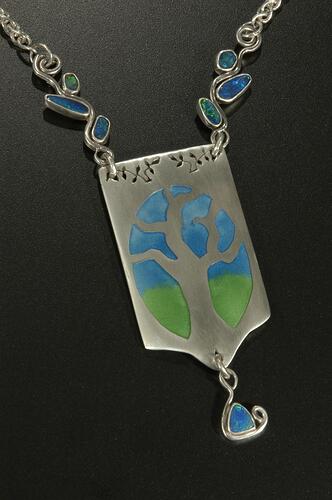Materials: Sterling silver, enamel, boulder opals
Dimensions: 3 inches X 1.5 inches (pendant) on a 16 inch chain
A tree in early spring is depicted in champleve enamel. Color in this necklace is an embodiment of the power of regeneration.
Photo credit: Jack B. Zilker
Priscilla Frake
Priscilla Frake Studio Jewelry and Enamel
Sugar Land, Texas. USA
I am a studio jeweler in Sugar Land, Texas, who has been making jewelry and sculpture since the late 1990's. I have studied at Revere Academy of Jewelry Arts, Taos School of Art, and Glassell School of Art. My artwork has been juried into many local and national exhibits. I work mainly in silver, copper, and enamel.
I believe in beauty, and its ability to make us feel at home in the world. When we become jaded or estranged, we stop paying attention to the consequences of our actions. Jewelry gives us a physical connection to beauty that is both tactile and visual, and reminds us of our joys and obligations as citizens of the earth. A piece of jewelry is a miniature world we can carry around with us, a personal talisman that can express our mood or display an alternate personality, a touchstone that can remind us of who we are and how we want to carry ourselves. These are the things I hope to create in each piece I make.
My current work involves an exploration of modern and ancient images of the cosmos. I am inspired by photographs from the Hubble Space Telescope, and also by illustrations from Renaissance and alchemical texts. My work attempts to investigate the disparity between what we feel about the universe and what we now know about it. We no longer live in a mechanistic world that can be reduced to simple natural laws or dogmas. At what point will our mythologies catch up with our knowledge? Can we extract order, pattern, or harmony from our lives in the midst of frantic change? What new forms of ornament can express this? As an artist, I acknowledge a responsibility to search for ways to create context and meaning that helps connect people to each other and the world.
The exhibition explores metal works whose primary theme is color embraced as their primary visual focus, whether that be using colored materials, exploring creating colored surfaces, or encasing the object in color.
As the world's largest jewelry related internet site, Ganoksin strives to develop exhibitions showcasing work from around the world. This exhibition was open to all metalsmiths, professional and amateur, advanced and beginner.
In total 303 artists contributed 814 show pieces for the permanent online exhibition.
The exhibition was curated by Beth Wicker, President of the North Carolina Society of Goldsmiths in the United States, and Adjunct Instructor at Northeastern Technical College in South Carolina. Director of the exhibition is Hanuman Aspler, founder of The Ganoksin Project, the world's largest internet jewelry site.
Hue is one of the primary properties of color, it refers to the place the color occupies on the visual spectrum. Humans have used hues throughout time, to create cave paintings, to decorate themselves, their clothing and their housing.
Different hues have taken on different meanings throughout time. Gold traditionally has been a color of purity - the metal gold is relatively unchangeable, and the hue of gold has come to stand for gods and goddesses, for royalty, for durability and for purity. Red has often meant love, or passion. Hues often reflect the meaning of the seasons, with pastels referring to spring and the burst of new life after the pale hues of winter. Summer is reflected in vibrant, deep hues, followed by the browning of hues in the fall as plants go to seed and die, and the land turns fallow.
The worth of a hue has often been tied to what is necessary to make the pigment that creates the hue, and the expensive involved in the process. Often created from crushed stones that had to be mined and carried by caravan over thousands of miles, or from fermented roots of plants only grown in certain areas, or the carapaces of rare insects - the creation of hue in a way that could be used by man was an involved and generally expensive process.
In today's world metalsmiths have access to perhaps the widest range of materials and hues in the history of man - and in some of the most affordable ways ever.
This exhibition celebrates hue - color - as an integral, inherent element of the work. We talk of the "richness" of color, and examples of this abound here. One expects hues from the colors of gemstones used in metalsmithing, but we also have hues from some less expected places. Glass enamels are an ancient way of adding color, as are a variety of patinas. Today's artists also use synthetic man-made materials to add color in ways that didn't exist a century ago.
We invite you to enjoy this celebration of hue, and the ways hues and their use have changed over time.
